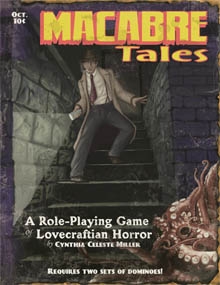Macabre Tales
Macabre Tales is a complete modern horror, Cthulhu role-playing game using dominoes written by Cynthia Celeste Miller and published by Spectrum Games.
By Cape Rust

In a market flooded with new RPGs, introducing new mechanics, it is hard to find a product that stands out; however, Macabre Tales from Spectrum Games does just that. This storytelling game uses dominoes instead of dice to help create tension and elements of randomness that most role-players crave. The truly amazing thing about this game is not the use of dominoes instead of dice, it is the loving and thoughtful care put into this product that really sets it above and beyond other games.
Macabre Tales is a horror RPG based on, inspired by, and sodden with goodness from the pulp master of macabre, H.P. Lovecraft. Many people have heard of Lovecraft and to say he still has a cult following would be… well… This storytelling RPG focuses on explorations of the moldering universe portrayed by Lovecraft set during the 1920s and 30s. This is not a historical RPG! The author Cynthia Celeste Miller and Spectrum Games are best known for producing genre based games. Some might argue that there isn’t a big difference, but there is. At no point does this game require that the narrator or the player research the time period any farther than reading some of Lovecraft’s works to get a better understanding of Lovecraft’s tenebrous view of the universe. This game is about the feel, not the facts.
In a day and age where tabletop gamers struggle to find a group of three or four people who can get together on a regular basis due to real life constraints and the addictive qualities of MMOs, it is comforting to see a game primarily designed for two. This two person design wasn’t born of laziness, but out of a combination of clever design and a true understanding of HP Lovecraft and his writing style. Miller accurately points out in the Macabre Tales rulebook that most of Lovecraft’s stories had one major protagonist (normally male) and the game reflects that style. Yes, there are rules for more than one player, but the soul of this game revolves around the main character trope. The other person in this tango has an interesting task ahead of them.
It truly takes two to tango and in the case of Macabre Tales, the second person in the game’s dynamic duo is the narrator. The narrator truly has the best and worst job possible, depending on how you look at things. The best part of being the narrator is devising ways of freaking or creeping out the other player in the most Lovecraftian way possible. This system is collaborative, but in the end this task falls on the shoulders of the narrator. Running any game is tough, but in the case of Macabre Tales, I would recommend a person who is more experienced at running games to run the first few sessions. I recommend this not because the system is difficult to grasp though, I recommend this because there is huge potential for the narrator to have to not only create a specific mood but to improvise based on the protagonist’s actions. I love to improvise during game sessions, but some people find improvisation noisome. Fortunately, Ms. Miller and company have included a concise guide for the narrator. This guide is one of the areas that truly show how much the author loves H.P. and his writings.
The player’s guide portion of this book was another stand out. Player’s guides have gotten better and better over the years and Macabre Tales does quite a bit to further this essential movement. This book takes the player aside and says, “Look, you are more than half of the equation in Macabre Tales. The story focuses on you and your actions. If you are accustomed to being railroaded during games, this system will blow your mind.” The player really does get to make choices and it is incumbent upon the narrator to adjust accordingly. What I love about this player’s guide is that it flat out told you that you will have to work with the narrator to move the story along. Often I get the feeling that many more traditional games give you a vague feeling of us versus them. We are often taught how to lead, but rarely taught how to follow and Macabre Tales does just that. To keep things in the spirit of Lovecraft, Macabre Tales encourages the player to throw a bit of common sense and sanity out the window for the sake of the story. Yes ladies and gentleman, we have a game that encourages you, as a player, to do everything horror movies tell you should not be done.
Scary house on the hill with strange buzzing sounds? Go check it out! Town that the federal government raided and blew up a reef? Go vacation there! A strange family who lives out in the middle of nowhere who has strange ways? Go visit them to write a story, or better yet, have your car break down in the middle of a torrential rain storm and slog over to their house. They will take care of you! Power gamers beware, this game isn’t about player survival or even player progression. It is about the story. Let’s move on to the rule book itself.
The entire rule book comes in at 93 pages in PDF format and every page counts, in the best possible way. The cover art shows you exactly what you are getting. The cover depicts a fedora and trench coat clad man, cigarette hanging from his mouth, heading down a darkened stone staircase with a flashlight. At the bottom of the stairs, just outside of the beam of the flashlight, lies a mass of tentacles. The cover is made to look like the cover of one of the dime novels that many of Lovecraft’s tales originally appeared in. This attention to detail shows just how much the author cares. There is a footer that lets the reader know that the game requires two sets of dominoes as well. I’m glad this warning is on the cover as I would be pissed if I picked this up expecting to need my trusty polys only to find out I need dominoes instead.
The pages have a crinkled parchment template applied to them which adds to the pulp feel. The art in the book is all black and white and some of it is really good. There are a few pictures that felt like they came straight out of Lovecraft clip art, but at no time did I look at a picture and say WTF. The format of the book flows nicely and the examples of play are outstanding. My biggest complaint would be that the character sheet should make an appearance a little earlier in the book. The adventure at the end ties it all together well and is well thought out with just the right amount of information for narrator and player.
This game is a love letter to H.P. Lovecraft in the best possible way. I respect Ms. Miller’s unabashed love for H.P. without it getting in the way of a damn good game. I wouldn’t recommend running this game to people who have never run games in other systems though. If you have not read Lovecraft’s works, Macabre Tales is not only a great gateway drug, but Ms. Miller does an excellent job of portraying the feel of H.P. Lovecraft. Page 60 even has a short listing of words that Lovecraft was apt to use to add flavor to narration. Sections of this book could stand alone as how to run a good game or being a better player at the table articles. If you are a fan of Lovecraft, this book is for you; if you like collaborative story telling, this game is for you; if you love crunch and power gaming, you should play this game. It might just change how you view games and what you love about them. If you have no interest in horror collaborative storytelling games, read this book to pick up some pointers on running a better game or being a better player. This is a wonderful Con game that could easily be played in the normal four hour block.
For more information on Macabre Tales or Spectrum Games, head over to www.spectrum-games.com.




